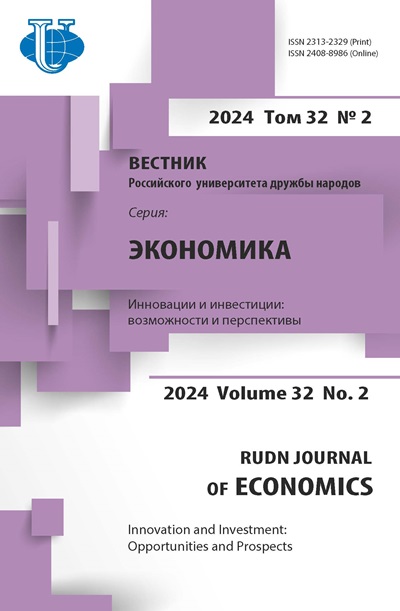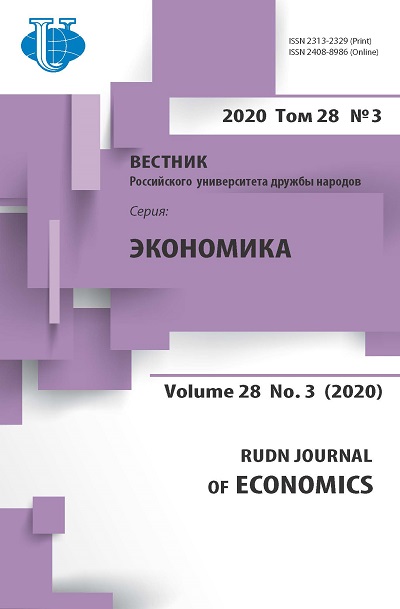Обоснование необходимости и анализ государственной поддержки агропромышленного комплекса в Российской Федерации
- Авторы: Каравдин А.А.1
-
Учреждения:
- Российский университет дружбы народов
- Выпуск: Том 28, № 3 (2020)
- Страницы: 585-596
- Раздел: ЭКОНОМИЧЕСКИЙ РОСТ И СОЦИАЛЬНО-ЭКОНОМИЧЕСКОЕ РАЗВИТИЕ
- URL: https://journals.rudn.ru/economics/article/view/24675
- DOI: https://doi.org/10.22363/2313-2329-2020-28-3-585-596
Цитировать
Полный текст
Аннотация
Вопросы, касающиеся государственной поддержки агропромышленного комплекса (АПК), являются актуальными для всех без исключения стран мира, в том числе и для Российской Федерации. В статье рассматриваются ключевые проблемы АПК, порождаемые в большей степени особенностями сельского хозяйства. Обосновывается необходимость государственной поддержки агропромышленного комплекса России на основе выделенных проблем. Анализируются направления и меры государственной поддержки в России, расхождения между заявленными в государственной программе развития агропромышленного комплекса целями и практическими результатами. Отсутствие комплексного подхода к решению имеющихся задач и должного контроля за выполнением госпрограммы, непродуманное и недостаточное финансирование отдельных программ, лоббирование крупными агрохолдингами своих интересов и монополизация сельскохозяйственного производства не позволяют рассчитывать на развитие малого агробизнеса и сельских территорий.
Об авторах
Андрей Андреевич Каравдин
Российский университет дружбы народов
Email: aka.kurgan@mail.ru
аспирант кафедры международных экономических от- ношений экономического факультета Российская Федерация, 117198, Москва, ул. Миклухо-Маклая, 6
Список литературы
- Bukshpan, A.A., Gusak, T.S., & Serdyuk, O.S. (2018). State support of agrarian and industrial complex in the Russian Federation in transitive economy. Ekonomika i biznes: teoriya i praktika [Economy and business: theory and practice], (9), 31-35. (In Russ.) doi: 10.24411/2411-0450-2018-10006
- Burmistrova, A.A., Rodionova, N.K., & Kondrashova, I.S. (2014). Gosudarstvennaya podderzhka sel'skogo khozyaistva vazhneishii faktor razvitiya APK Rossii [The state support of agriculture - the major factor of development of agrarian and industrial complex of Russia]. Sotsial'no-ekonomicheskie yavleniya i protsessy [Social-Economic Phenomena and Processes], 9(3), 14-16. (In Russ.)
- Federal Law dated 29.12.2006 (ed. 25.12.2018) No. 264-FZ “On Agricultural Development”. (In Russ.) Retrieved April 19, 2020, from http://www.consultant.ru/cons/cgi/online. cgi?from=286510-0&rnd=B88CFD8D0C70C944E569E73C0BF6187A&req=doc&base= LAW&n=314385&REFDOC=286510&REFBASE=LAW#9kjkx80tmo
- Federal State Statistic Service. Retrieved from www.gks.ru (In Russ.)
- Information guide on measures and directions of state support of the agroindustrial complex of the Russian Federation. Retrieved February 25, 2020, from http://www.gp.specagro.ru (In Russ.)
- Istomina, L.A. (2013). Analiz gosudarstvennoi podderzhki APK [Analysis of state support for agriculture]. Bulletin of Udmurt University. Series Economics and Law, (2), 47-51. (In Russ.)
- Kamilov, M.K., & Kamilova, P.D. (2012). Gosudarstvennoe regulirovanie i podderzhka APK Rossii posle vstupleniya v VTO [Government regulation and support of Russia agriculture after WTO]. Regional'nye problemy preobrazovaniya ekonomiki [Regional problems of transforming the economy], (2), 181-187. (In Russ.)
- Karavdin, A.A. (2016). To a question of government regulation of agro-industrial sector of the economy. Conference Papers of the VIII International scientific and practical conference “Innovation in Agriculture” (Moscow, April, 20-22, 2016) (pp. 146-149). Moscow, RUDN University. (In Russ.)
- Maslova, V.V. (2018). Sovershenstvovanie ekonomicheskogo mekhanizma v agrarnom sektore ekonomiki [Improvement of the economic mechanism in the agricultural sector]. Budushchee sel'skikh territorii Rossii v kontekste razvitiya agrarnogo mira (MEF-2018) [The Future of rural areas of Russia in the context of the agricultural world (MEF-2018)] (pp. 65-72). Moscow. (In Russ.)
- Ministry of Agriculture of the Russian Federation. Retrieved from http://mcx.ru/ (In Russ.)
- OECD. (2020). Agricultural support. Retrieved February 25, 2020, from https://data.oecd.org/ agrpolicy/agricultural-support.htm
- Primakov, E.M. (2011). Mysli vslukh [Thinking out loud]. Rossiyskaya Gazeta, 135(5511). (In Russ.)
- Privalova, S.G. (2009). Teoreticheskie aspekty gosudarstvennoi podderzhki APK [Theoretical aspects of state support of agriculture]. Agrarnyi vestnik Urala [Agrarian Bulletin of the Urals], (12), 20-25. (In Russ.)
- Shagaida, N.I., & Uzun, V.Ya. (2017). Tendentsii razvitiya i osnovnye vyzovy agrarnogo sektora Rossii. Analiticheskii doklad RANKhiGS [Development trends and main challenges of the Russian agricultural sector. Analytical report of RANEPA]. Moscow, Tsentr strategicheskikh razrabotok Publ. Retrieved May 25, 2020, from https://www.csr.ru/ wp-content/uploads/2017/11/Doklad_selskoe_hozyai-stvo_veb.pdf (In Russ.)
- Shutkov, A.A., & Shutkov, S.A. (2016). Resursno-innovatsionnaya strategiya importozameshcheniya: problemy formirovaniya i realizatsii [Resource-innovative strategy of import substitution: problems of formation and implementation]. Ekonomika sel'skogo khozyaistva Rossii [Russian agriculture economics], (1), 11-19. (In Russ.)
- Ushachev, I.G. (2016). Nauchnye problemy importozameshcheniya i formirovaniya eksportnogo potentsiala produktsii agropromyshlennogo kompleksa Rossii [Scientific problems of import substitution and formation of export potential of agricultural products of Russia]. APK: ekonomika, upravlenie [Economics and management of agriculture], (1), 4-22. (In Russ.)
- Ushachev, I.G. (2017). Sovremennye tendentsii i vzglyad v budushchee razvitiya APK Rossii [Modern trends and a look into the future of the development of the AIC of Russia]. Prikladnye ekonomicheskie issledovaniya [Applied economic research], (2), 4-7. (In Russ.)
- Uzun, V.Ya. (2019). Gosprogramma kompleksnogo razvitiya sel''skikh territorii: analiz proekta [State Program of Integrated Development of Rural Territories: Project Analysis]. Ekonomicheskoe razvitie Rossii [Economic development of Russia], 26(5), 30-34. (In Russ.)















